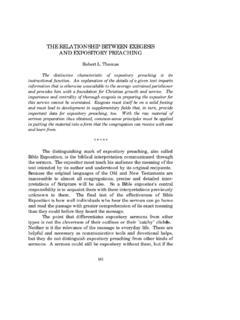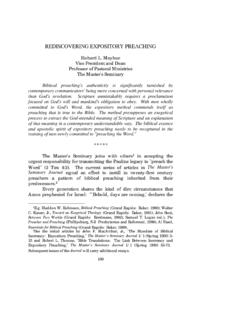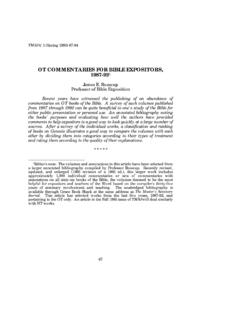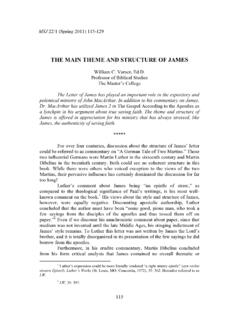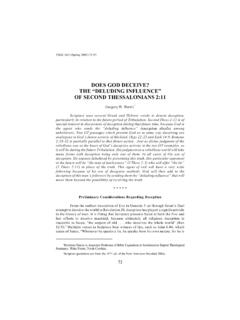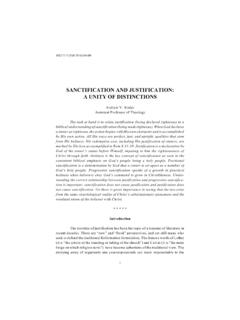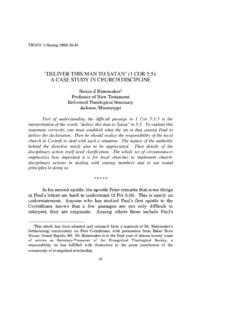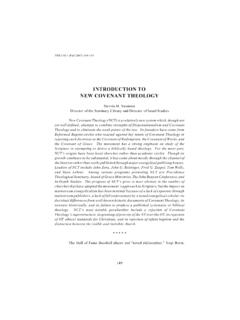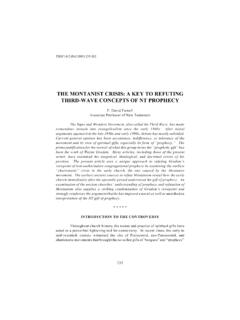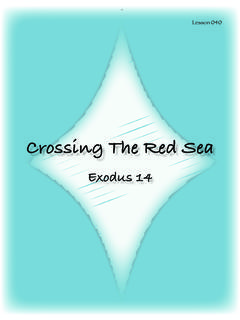Transcription of EXEGETICAL AND CONTEXTUAL FACETS OF ISRAEL’S RED …
1 *Professor Overstreet is Professor of Pastoral Theology at Northwest Baptist Seminary, Tacoma, B. Redford, Observations on the Sojourn of the Bene-Israel, in Exodus: The EgyptianEvidence, eds. Ernest S. Frerichs and Leonard H. Lesko (Winona Lake, Ind.: Eisenbrauns, 1997) 14/1 (Spring 2003) 63-86 EXEGETICAL AND CONTEXTUAL FACETS OFISRAEL S RED SEA CROSSINGR. Larry Overstreet*If one accepts the inerrancy of the Bible, locating Israel s crossing of theRed Sea in Exodus 14 15 any place other than the northwestern arm of the Red Sea( , the Gulf of Suez) is practically impossible. Reasons for such a placementinvolve direct references to yam s ph in Num 33:10-11; Exod 10:19; 23:31; Num21:4; Deut 1:40; 2:1; Judg 11:16; 1 Kgs 9:26; Jer 49:21 and an indirect referenceto the body of water in Isa 11:15. The writings of Herodotus, Pindar, and Strabofurnish further evidence that DL2D 2V8"FF" (erythr thalassa, Red Sea ) wasthe name correctly applied to the place of Israel s crossing .
2 From writers involvedwith translating the LXX and The Genesis Apocryphon and from Josephus comeseven more proof of that location. In two instances the NT verifies the Red Sea terminology as correct when referring to the exodus. S ph means end or termination rather than reeds. Details of the Red Sea crossing require asupernatural intervention that created a substantial opening in the sea to allow somany Israelites to cross in such a short time.* * * * *INTRODUCTIONSome scholars doubt or openly deny the historical reality and validity of thebiblical account of the exodus. One example of this was seen in a conference ofhistorians, archaeologists, and Egyptologists at Brown University in 1992. Speakersmade such statements as the following: The themes of the Sojourn and the Exodus,as embellished in the Pentateuch, belong in the realm of folklore to a large extent, 164 The Master s Seminary Journal2 William G. Dever, Is There Any Archaeological Evidence for the Exodus?
3 , in Exodus: TheEgyptian Evidence , of the doctrinal statement of the Evangelical Theological H. Snaith, 4|2<.* [sic]: The Sea of Reeds: The Red Sea, VT 15 (1965):395. Nearlythirty years earlier Montgomery observed, It has become customary to explain the name by a revisionof the tradition of the crossing of the Red Sea at the Exodus, whereby the waters crossed were those ofthe swampy pools in the isthmus of Suez, with which theory the identification of the word s p withEgyptian for papyrus would agree (James A. Montgomery, Hebraica, JAOS 58 (1938) V. Brisco, Exodus, Route of the, The International Standard Bible Encyclopedia, ed.,Geoffrey W. Bromiley (Grand Rapids: Eerdmans, 1982) maps a proposed route through Lake F. Pfeiffer and Howard F. Vos, The Wycliffe Historical Geography of Bible Lands(Chicago: Moody, 1967), map 2, map of a proposed route through Lake H. Merrill, Numbers, in The Bible Knowledge Commentary, Old Testament, eds. JohnF.)
4 Walvoord and Roy B. Zuck (Wheaton: Victor, 1985) 253, has a proposed route through Lake and Vos, Wycliffe Historical Geography 90, map of a proposed route through the area ofLake Timsah and the Northern Bitter L. Kelm, Escape to Conflict: A Biblical and Archaeological Approach to the HebrewExodus and the Settlement in Canaan (Fort Worth, Tex.: IAR, 1991) 64, maps of a proposed routethrough the Southern Bitter Not only is there no archaeological evidence for an exodus, there is no needto posit such an event. We can account for Israelite origins, historically andarchaeologically, without presuming any Egyptian background. 2 Concerning thecrossing of the Red Sea a participant said, Moving on to the Sinai tradition, thecrossing of the Red (Reed) Sea is obviously a miraculous tale that can in no way bevalidated or even illuminated by archaeological investigation. 3 The purpose of this article is not to argue against such positions. Instead,it accepts the presupposition that The Bible alone, and the Bible in its entirety, isthe Word of God written, and therefore inerrant in the autographs.
5 4 With thatassumption, the problems related to the events of the exodus, including the crossingof the Red Sea, are worthy of careful investigation. Among interpreters who do interact with the problems of the exodus, manycommonly accept that Israel crossed a sea of reeds (yam s ph), rather than actuallycrossing the northwestern arm of the Red Sea (that is, the Gulf of Suez). In 1965 Snaith wrote that the rendering the sea of reeds had lately become fashionable. 5 Proposed sites for the crossing include: Lake Sirbonis,6 Lake Menzaleh,7 LakeBallah,8 Lake Timsah or the northern Bitter Lakes,9 or the southern Bitter reasons for postulating a crossing site distinct from the RedSea itself include: identifying the phrase Sea of Reeds as a common noun ratherthan a proper name, that the Gulf of Suez has no reeds (and the word s ph is takento mean that in Exod 2:3), that the Shur Desert is in northwest Sinai (too far awayExegetical and CONTEXTUAL FACETS of Israel s Red Sea crossing 6511In contrast to conservatives, liberal scholars have various positions regarding the yam-s ph.)
6 Forexample, Kloos connects the whole story of the Reed Sea with an alleged Canaanite mythologicalinfluence on Israel (Carola Kloos, Yhwh s Combat with the Sea: A Canaanite Tradition in the Religionof Ancient Israel [Leiden: E. J. Brill, 1986] 191).Towers has another theory. He asserts that it cannot be proved whether or not an actual place calledthe yam-s ph ever existed, but that some Egyptian texts indicate that the Sea of Reeds referred to the world beyond (John Robert Towers, The Red Sea, Journal of Near Eastern Studies 18 [1959]:150).McCarthy takes yet another approach. He provides a literary analysis of Exod 5 14 and concludesthat chapters 11 13 are not an originally integral part of a literary whole which included theintroduction in ch. 5 and the stories of the plagues in chs. 78-1027 with their special structure andvocabulary (Dennis J. McCarthy, Plagues and Sea of Reeds: Exodus 5 14, Journal of BiblicalLiterature 85 [1966]:149).
7 Childs, while agreeing with the idea of a mythological battle with Yam which was commonthroughout the Ancient Near East (413), also agrees that distinct traditions of the exodus and thewilderness cycle were combined over an extended period (Brevard S. Childs, A Traditio-HistoricalStudy of the Reed Sea Tradition, Vetus Testamentum 20 [1970]:413, 418).from the Red Sea), that the Gulf of Suez is too far south from Pi Hahiroth andMigdol, and that Baal Zephon is to be associated with Tahpahnes in the northeastdelta region. In view of these reasons, the conclusion is that Israel must have crossednorth of the Gulf of Suez arm of the Red Sea at another location. Many conservativescholars who fully accept the miraculous nature of the crossing of the sea, with itsattendant judgment on the Egyptian pursuers, advocate this essay does not interact with those arguments. However, an exegeticaland CONTEXTUAL evaluation of relevant biblical references to the Red Sea may requirereconsideration which will lead to another conclusion.
8 The tables at the end of theessay identify the biblical references to the Red Sea, and the quantity of referencesindicates the importance that biblical writers placed on this body of water. Exegetesneed to consider carefully, therefore, the total impact of their conclusions whenevaluating the term in any particular location, particularly that in Exodus 14 essay will focus attention first on significant OT references to the term yam s phapart from those in Exodus 14 15. Pertinent observations will then be madeconcerning additional historical references and the NT references to the Red , a few comments concerning the context of Exodus 14 15 will culminate thepresent OT AND THE YAM-S PHIn order to visualize correctly the location of the bodies of water underdiscussion, a map showing the entire Red Sea, the Arabian Sea (northern part of theIndian Ocean), and the Persian Gulf will provide helpful reference points. The gulfsof Aqaba and Suez extensions of the Red Sea have special relevance to the exodussince the Peninsula of Sinai is between those two The Master s Seminary Journal12 Timothy R.
9 Ashley, The Book of Numbers. The New International Commentary on the OldTestament, ed., R. K. Harrison (Grand Rapids: Eerdmans, 1993) , The Sea of Reeds J. Budd, Numbers, Word Biblical Commentary, vol. 5, eds. David A. Hubbard and GlennW. Barker (Waco, Tex.: Word, 1984) B. Allen, Numbers, The Expositors Bible Commentary, vol. 2, ed. Frank E. Gaebelein;(Grand Rapids: Regency-Zondervan, 1990) A. Kitchen, Red Sea, in The Zondervan Pictorial Encyclopedia of the Bible, ed. Merrill (Grand Rapids: Zondervan, 1975) ph and the Gulf of SuezThe Hebrew term 4&2 .* (yam s ph) appears in many OT passages. Someof these refer directly to the western arm of the Red Sea known as the Gulf of 33:10-11 Numbers 33 summarizes the journeys of Israel from their exodus to theirarrival at the eastern side of the Jordan River. The miraculous crossing of the sea isgiven in 33:8. After that event they journeyed three more days and camped atMarah. They then traveled to Elim where they camped.
10 Leaving Elim they movedon to an encampment by the Red Sea (33:10). Leaving that location they nextjourneyed from the Red Sea to the wilderness of Sin (33:11). This text thusindicates that Israel journeyed at least five days after the miraculous crossing of thesea (33:8), and they were still alongside the Red Sea after all that movement. Ashley finds it surprising that the yam-s ph is not mentioned until threestops after the crossing through the midst of the sea. He theorizes that in this texttraditions were combined which did not originally belong together, but he alsoadmits, While the words [yam-suph] are clearly used to describe the Gulf ofAqabah, they may also designate the Gulf of Suez. 12 Snaith, like Ashley, seesstrands from JEPD through the Pentateuchal narrative, and thinks that Apparentlythe sea which the Israelites crossed was somewhere by the Bitter Lakes, but he alsorecognizes that in Num 33:8-10 the yam-s p mentioned here is the Gulf of Suez.
